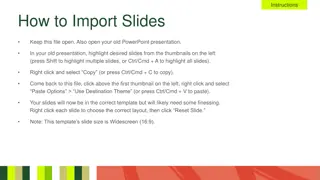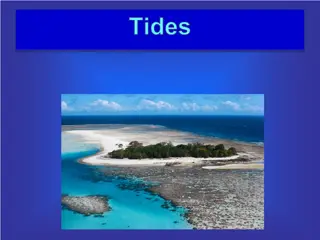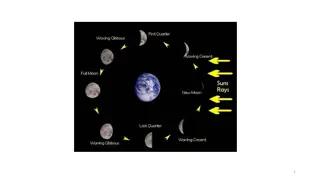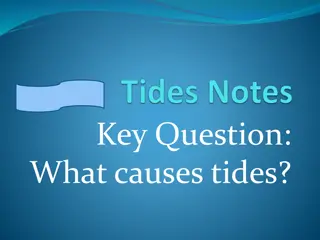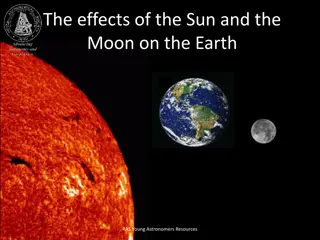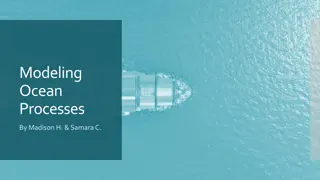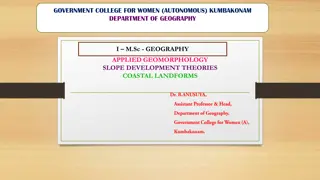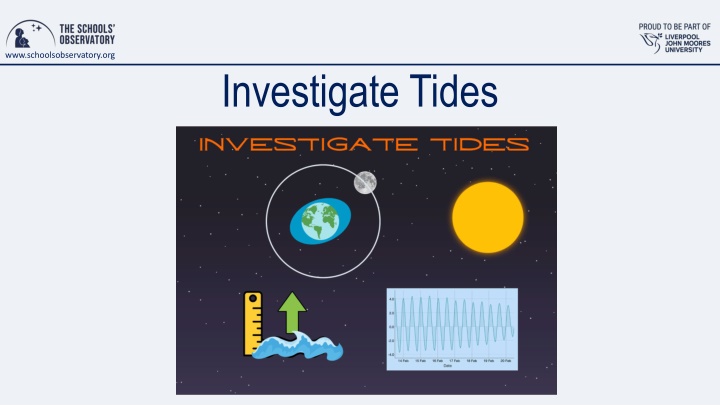
Tides: Causes, Types, and Phenomena
Explore the fascinating world of tides and their connection to the Moon and the Sun. Learn about the gravitational forces that create tidal bulges, the phenomenon of high and low tides, and the differences between spring and neap tides. Discover why tides occur at different times each day and how they are influenced by celestial alignments. Dive deeper into the science behind this natural occurrence and broaden your understanding of Earth's dynamic oceans.
Download Presentation

Please find below an Image/Link to download the presentation.
The content on the website is provided AS IS for your information and personal use only. It may not be sold, licensed, or shared on other websites without obtaining consent from the author. If you encounter any issues during the download, it is possible that the publisher has removed the file from their server.
You are allowed to download the files provided on this website for personal or commercial use, subject to the condition that they are used lawfully. All files are the property of their respective owners.
The content on the website is provided AS IS for your information and personal use only. It may not be sold, licensed, or shared on other websites without obtaining consent from the author.
E N D
Presentation Transcript
www.schoolsobservatory.org Investigate Tides
www.schoolsobservatory.org What are tides? Tides are the rise and fall of sea levels caused by the gravitational pull from the Moon and the Sun. Tides are predictable and follow daily and monthly cycles. The Moon s gravity pulls water toward it, creating a tidal bulge. The Sun s gravity also affects tides, but its impact is weaker than the Moon s. Image Credit: Dan Gold
www.schoolsobservatory.org How gravity create tidal bulges? To understand tides, think of Earth as a sphere with two layers: The outer layer is the ocean. The inner layer is the solid ground beneath it. Gravity pulls differently on these layers. The difference in the size of the force stretches the ocean water, creating tides. Image Credit: TSO Since water can move easily, it forms bulges where the gravitational pull is strongest.
www.schoolsobservatory.org Why are there 2 high and 2 low tides per day? As the Earth rotates, each coastal location passes through two bulges of water per day Tides occur about six hours apart. This results in 2 high tides and 2 low tides approximately every 24 hours. Image Credit: TSO
www.schoolsobservatory.org Spring and Neap Tides Spring Tides When the Earth, Sun and Moon are in a line (Syzygy), the Sun s gravity adds to the tidal force of the Moon increasing the tidal bulges (higher high tides). This occurs in the New Moon and Full Moon phases. Image Credit: TSO
www.schoolsobservatory.org Spring and Neap Tides Neap Tides When the Moon and Sun are at right angles to Earth, the solar gravity reduces the Moon s contribution to the tidal bulge. This occurs in the First and Third Quarter Moon phases. Image Credit: TSO
www.schoolsobservatory.org Why do tides happen later each day? If you looked up and saw the Moon in a certain position above you, you might think it'll next be in that position after 24 hours - the times it takes for the Earth to rotate once on its axis. But the Moon moves in the same direction as the spinning Earth. This means that after 1 rotation, the Moon is slightly ahead of where it was before. It takes extra time for the Earth to spin some more and 'catch up' to the Moon. Image Credit: National Ocean Service
www.schoolsobservatory.org Real-Life Tides Beyond the Model In the real world, tides are influenced by more than just the Moon s and Sun s gravitational pull: Ocean depth & shape (bathymetry) Tides move differently in deep vs. shallow areas. Landmasses Continents block and change the direction of tidal movement. Local geography Some locations have no tides at all. Image Credit: Scijinks
www.schoolsobservatory.org Types of Tides Semi-diurnal tides Two high and two low tides per day (not always equal). Diurnal tides Only one high and low tide per day (for example places near the pole). Mixed tides Unequal high and low tides each day. Image Credit: TSO Some places have no tides at all. These areas are called amphidromic points, where tidal movement cancels itself out.

